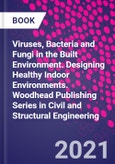Viruses, Bacteria and Fungi in the Built Environment: Designing Healthy Indoor Environments opens with a brief introduction to viruses, bacteria and fungi in the built environment and discusses their impact on human health. Sections discuss the microbiology of building materials, the airborne transmission of viruses and bacteria in the built environment, and plumbing-associated microbiome. As the first book on this important area to be written in light of the COVID-19 pandemic, this work will be a valuable reference resource for researchers, civil engineers, architects, postgraduate students, contractors and other professionals working and interested in the field of the built environment.
Elements of building design, including choice of materials, ventilation and plumbing can have important implications for the microbiology of a building, and consequently, the health of the building's occupants. This important new reference work explains the microbiology of buildings and disease control in the built environment to those who design and implement new construction and renovate.
Please Note: This is an On Demand product, delivery may take up to 11 working days after payment has been received.
Table of Contents
1. IntroductionPart 1: Basics of Microbiology and Pathogenic Contamination
2. Basics of microbiology in the built environment
3. Opportunistic premise plumbing pathogens in the built-environment"
4. Influence of materials on biofilm formation
5. Black fungi in the built environment-the good, the bad, and the ugly
6. "Air and wall mycobiota interactions a case study in the Old Cathedral of Coimbra"
7. Airborne transmission and indoor air pollution
8. Airborne bacteria and sick building syndrome
Part 2: Strategies for Monitoring and Control of Indoor Pathogens
9. Fungal contamination assessment in Healthcare environments
10. Indoor fungi threshold levels
11. Smart technologies for Covid-19 indoor monitoring
12. Ventilation strategies for healthy indoors in hospitals
13. Innovative coating materials to prevent fungi growth
14. Indoor fungal control by galvanic cells








